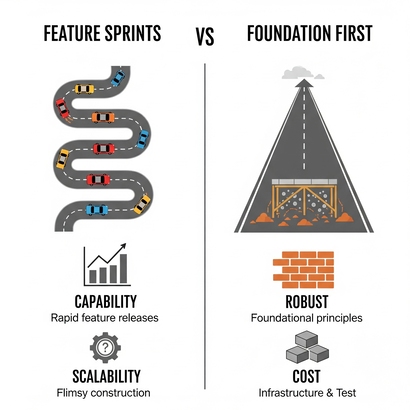
The “Features First” Gamble: When to Build and When to Fortify Your Software’s Foundations
In the fast-paced world of software development, a fundamental tension perpetually simmers: the drive to dazzle users with a constant stream of new features versus the need to build and maintain a robust, scalable, and reliable underlying infrastructure. Many teams, especially in their early days, lean heavily into a “features first” approach. This strategy can be a powerful engine for growth, but it’s a gamble – a form of technical debt that, if not managed wisely, can lead to significant problems down the line. The key isn’t to avoid this debt entirely, but to incur it strategically and repay it diligently.
The Allure of “Features First”: The Pros
Why do so many opt to prioritize features over foundational work like CI/CD pipelines, comprehensive testability, and scalable environments? The attractions are compelling:
- Speed to Market: In a competitive landscape, being the first or fastest to introduce a solution can be a game-changer. Prioritizing features allows for the rapid development of a Minimum Viable Product (MVP) or the quick rollout of new functionalities to capture market share or validate business hypotheses.
- Rich User Feedback Loop: More features, delivered faster, mean more opportunities for user interaction and feedback. This continuous input is invaluable for iterating on the product and ensuring it aligns with user needs and desires.
- Attracting Early Adopters & Investment: Tangible features are what users see and interact with. A product brimming with functionality is often more appealing to early adopters and can be crucial in securing initial traction and vital investment.
- Focus on Immediate Perceived Value: Features directly address user problems and deliver immediate, visible value. This satisfies users and often aligns with the short-term goals of stakeholders who want to see rapid progress and market impact.
The Hidden Costs: The Cons of Neglecting Infrastructure
While the “features first” approach can offer short-term gains, deferring investment in infrastructure – CI/CD pipelines, testability, robust environments – accrues technical debt. This debt has a compounding interest rate:
- Mounting Technical Debt: Quick workarounds, insufficient testing, and poorly planned architecture create a codebase that becomes increasingly difficult and costly to change, debug, and scale. Each new feature built on a shaky foundation adds to this instability.
- Slower Long-Term Velocity: Ironically, the initial speed gained by cutting corners eventually leads to a significant slowdown. As complexity and instability grow without solid infrastructure (like automated CI/CD pipelines and comprehensive test suites), adding new features or fixing bugs becomes an arduous and time-consuming process.
- Scalability Nightmares: An architecture that performs adequately for a handful of users can crumble under the pressure of thousands or millions. Insufficient infrastructure planning often leads to performance bottlenecks, frequent downtime, and ultimately, frustrated and lost users.
- Decreased Developer Morale: Engineers forced to constantly battle a brittle codebase, deal with flaky tests, manually deploy complex systems, or firefight preventable issues can quickly become demoralized and burnt out. High turnover in the engineering team can be a direct consequence.
- Security and Reliability Risks: In the rush to deliver features, crucial security considerations can be overlooked, and system reliability can be compromised, leading to data breaches or a poor user experience.
- The “Big Rewrite” Trap: If technical debt is allowed to accumulate unchecked for too long, the system can become so unwieldy that the only viable option appears to be a costly, risky, and time-consuming complete rewrite.
When the Gamble Doesn’t Pay Off: Cautionary Tales
The “features first” approach, while tempting, is not without its casualties. When the accumulation of technical debt and neglect of infrastructure go unchecked for too long, even promising ventures can falter or fail. These cautionary tales highlight the severe risks:
-
Friendster (Early Social Network): A trailblazer in social networking, Friendster amassed millions of users with its novel features. However, the platform became notoriously slow and unreliable as it grew. The underlying technology couldn’t scale to meet the demand, leading to excruciatingly long load times and a frustrating user experience. While competitors like MySpace and Facebook emerged with more stable (at the time) platforms, Friendster’s inability to address its deep-seated performance issues, despite attempts to re-architect, became a significant factor in its decline and eventual fade from prominence in key markets. The initial feature-driven success was ultimately undermined by a crumbling foundation.
-
Digg (The v4 Relaunch Disaster): Once a dominant force in social news aggregation, Digg’s attempt at a major overhaul with its “v4” relaunch in 2010 serves as a stark warning. The new version, packed with ambitious features and a completely redesigned user experience, was rolled out with numerous bugs, significant performance problems, and controversially removed features cherished by its loyal community. The backlash was immediate and severe, leading to a mass user exodus. While Digg didn’t shutter immediately, the v4 fiasco critically wounded the platform, demonstrating how a feature-centric push, without ensuring the stability, scalability, and readiness of the underlying system (and community acceptance), can backfire spectacularly.
-
General E-commerce Failures (Dot-com Era): The dot-com bubble saw a surge of e-commerce startups eager to capture the new digital frontier. Many focused intensely on launching quickly with a plethora of features and extensive product catalogs to attract eyeballs and investment. However, a common pattern among those that failed was a severe neglect of the backend infrastructure. Issues like inadequate inventory management systems, unreliable order processing, and an inability to handle peak traffic loads led to poor customer experiences, operational chaos, and ultimately, financial unsustainability. Their feature-rich storefronts couldn’t compensate for the foundational weaknesses.
-
MySpace (A Complex Decline with Technical Debt as a Factor): While MySpace’s decline was multi-faceted, involving evolving user preferences, corporate strategy, and fierce competition from Facebook, technical aspects played a notable role. As Facebook offered a cleaner, faster, and more consistent user experience, MySpace struggled with a cluttered interface, slower performance, and greater allowance for user-generated customizations (like custom HTML/CSS) that often further degraded performance and aesthetics. The platform found it difficult to innovate and iterate at the same pace, partly due to the weight of its existing codebase and infrastructure decisions. While not a simple case of “features vs. infrastructure,” the inability to evolve the platform gracefully and maintain performance likely contributed to its loss of users.
These examples, though varying in their specifics, underscore a common theme: a relentless pursuit of features without commensurate investment in the underlying architecture, scalability, and quality assurance can lead to a product that is difficult to maintain, painful to use, and ultimately, unable to compete or survive. The initial velocity gained by cutting corners on infrastructure can be entirely negated by the eventual drag of crippling technical debt.
Giants Who Gambled (and Mostly Won): Real-World Examples
Many of today’s tech giants started with a strong focus on feature velocity, knowingly or unknowingly accumulating technical debt, which they later had to address.
-
Twitter: In its early explosive growth phase, Twitter prioritized features and user acquisition. The platform’s struggles with scalability became legendary, symbolized by the “Fail Whale” error page. This period of rapid feature development was eventually followed by massive investments in infrastructure, including a shift from Ruby on Rails to a JVM-based backend, the development of robust analytics platforms, and building out their own data centers to handle the immense scale.
-
Facebook: Famously starting as a PHP application on a single rented server, Facebook’s initial strategy was all about rapid rollout, campus by campus. Mark Zuckerberg’s early motto, “Move Fast and Break Things,” epitomized this feature-first philosophy. As user numbers skyrocketed, they encountered severe scaling challenges, forcing them to innovate with techniques like database partitioning and eventually leading to the design and construction of highly customized, large-scale infrastructure (e.g., the Open Compute Project).
-
Instagram: Launched with a Python/Django monolithic architecture hosted on AWS, Instagram’s team was able to iterate incredibly quickly, leading to rapid user adoption. This initial focus on features and user experience was key to their early success. As they scaled to handle millions of users, they strategically transitioned to a microservices architecture, optimized their data storage solutions (like adopting Cassandra), and after being acquired by Facebook, were able to leverage Facebook’s even more extensive infrastructure.
-
Airbnb: Airbnb began its journey with a Ruby on Rails monolith, affectionately nicknamed “Monorail.” This allowed the founders to iterate quickly and achieve crucial product-market fit. However, as the company and the engineering team expanded, this monolithic architecture started to impede development speed, making testing and deployments increasingly painful. Recognizing this, Airbnb consciously began a journey towards a Service-Oriented Architecture (SOA) to improve scalability, enable teams to work more independently, and increase overall feature velocity.
These examples illustrate that an initial feature focus can be a pathway to success, but it’s almost always followed by a period of significant investment in infrastructure to sustain that success and enable future growth.
The Road Less Traveled (But Often Faster in the Long Run): Prioritizing Foundations
While the “features first” approach is common, some highly successful companies have demonstrated the profound benefits of embedding a strong engineering culture with a focus on robust infrastructure, comprehensive testing, and automation from relatively early in their journey. This path might seem slower initially, but it often leads to greater sustained velocity, higher quality, and more resilient scalability in the long run.
These companies don’t necessarily build everything perfectly upfront, but they instill principles and practices that treat infrastructure and testability as first-class citizens, not afterthoughts.
-
Google: While Google’s very earliest days were characterized by rapid innovation and less formal processes, as the company began to scale, it faced significant challenges that necessitated a cultural shift towards robust engineering practices. Initiatives like the “Testing on the Toilet” campaign, the development of sophisticated internal tools for automated testing (Test Automation Platform - TAP), continuous integration, and release management (Rapid) were crucial. Engineers at Google recognized that to manage the growing complexity and the sheer number of developers, they needed to automate rigorously and build for testability. This early (relative to their massive scaling curve) focus on engineering productivity and automated testing allowed thousands of teams to develop, integrate, test, and deploy code concurrently and reliably, forming the bedrock of Google’s ability to innovate and operate at an unparalleled scale. The investment in these foundations didn’t just fix problems; it accelerated future development by reducing friction and ensuring stability.
-
Netflix: Netflix’s transformation from a DVD rental service to a global streaming giant is a testament to its engineering prowess. Early on in their streaming journey, they made bold bets on cloud infrastructure (AWS) and pioneered the use of microservices. This architectural choice, while complex, was a strategic decision to enable scalability, resilience (“design for failure”), and independent team velocity. Netflix heavily invests in its platform, tooling, and extensive automation, including sophisticated testing environments like the Netflix Test Studio. Their renowned culture of “Freedom and Responsibility” empowers highly talented engineers to build and operate these complex systems. This early and continuous investment in a scalable, resilient infrastructure allowed Netflix to rapidly expand globally, experiment with new features, and handle massive traffic loads, ultimately accelerating its market dominance.
-
Stripe: In the high-stakes world of online payments, reliability, security, and developer experience are paramount. Stripe built its reputation on providing clean, robust, and well-documented APIs that developers love. This inherently requires a deep focus on infrastructure, quality, and meticulous testing from the get-go. While they also iterated quickly, the underlying engineering culture emphasized building for the long term. Their engineering blog and discussions by their leaders reveal a continuous investment in scaling their infrastructure, refining processes, and maintaining a high bar for code quality and system reliability. For Stripe, a solid foundation wasn’t a luxury but a core component of their product offering and a key differentiator that enabled them to gain trust and accelerate their growth in the competitive fintech space.
-
Modern Startups Embracing Foundations: We also see newer companies like Unify GTM (as detailed in their engineering blog) consciously choosing robust architectural patterns (e.g., Kubernetes, message queuing with Pulsar) and emphasizing a consistent engineering approach from their inception. Their stated goal is to build a platform capable of handling significant scale and complexity, suggesting an understanding that early foundational investments can prevent future bottlenecks and enable faster, more stable growth.
The common thread among these companies is the understanding that a solid technical foundation is not a cost center but an accelerator. It enables them to:
- Iterate with confidence: Knowing that robust testing and CI/CD pipelines will catch issues early.
- Scale smoothly: Without hitting predictable walls that require costly, time-consuming rewrites.
- Attract and retain talent: Engineers are often drawn to environments where they can do their best work on well-architected systems.
- Innovate faster in the long term: As they are not constantly bogged down by technical debt and firefighting.
This approach requires discipline and a willingness to invest time in non-feature work, but the long-term payoff in terms of speed, quality, and resilience can be immense.

Finding the Equilibrium: Maintaining Balance Between Features and Foundations
The challenge isn’t about choosing features or infrastructure, but about finding a sustainable balance. Here’s how to navigate this:
- Acknowledge Technical Debt is Real: The first step is recognizing that shortcuts and deferred infrastructure work have a cost. Make this debt visible, perhaps by logging it in the backlog alongside feature requests.
- Embrace the “Boy Scout/Girl Guide Rule”: Leave the codebase cleaner than you found it. Encourage small, incremental improvements to infrastructure, refactoring, and test coverage as part of regular development work.
- Strategic Pauses for Fortification: Don’t wait until the system is collapsing. Proactively allocate dedicated time for addressing technical debt and improving foundational elements. This could be a percentage of each sprint, dedicated “infrastructure sprints,” or “fix-it Fridays.”
- Invest in CI/CD Pipelines Early (or as early as feasible): Continuous Integration and Continuous Delivery/Deployment are force multipliers. Automating the build, test, and deployment processes improves both the speed and quality of releases, reducing friction for both feature development and infrastructure upgrades.
- Prioritize Testability from the Outset: Writing code that is easy to test might seem to take slightly longer initially, but it pays enormous dividends in the long run. Good test coverage allows for faster, safer changes and refactoring.
- Evolve Your Environments: As your product and team grow, so will the complexity of your needs for development, staging, and production environments. Invest in making them robust, easily replicable, and manageable.
- Listen to Your Engineers: They are on the front lines and are often the first to spot the cracks appearing in the system’s foundation. Create clear channels for them to voice concerns, suggest improvements, and contribute to infrastructure decisions.
- Foster Product and Engineering Partnership: Infrastructure work is not just an “engineering concern.” Product managers must understand that a stable, scalable, and maintainable platform is essential for consistent future feature velocity and overall user satisfaction. Prioritization of this work should be a collaborative effort.
- Measure and Monitor Key Metrics: Keep a close eye on metrics related to system performance (latency, error rates), deployment frequency, lead time for changes, bug density, and even developer satisfaction. These can act as early warning signs that your infrastructure is becoming a bottleneck.
Conclusion: The Long Game of Software Development
Prioritizing features over infrastructure isn’t an inherently flawed strategy; it’s often a pragmatic and necessary tactic, particularly in the nascent stages of a product’s lifecycle when speed and user feedback are paramount. The real peril lies in the indefinite postponement of infrastructure investment.
The most successful software companies recognize that this is a continuous balancing act, not a one-time decision. They understand that an initial sprint for features must, at some point, be complemented by a focus on building a solid and scalable foundation. This allows them not only to maintain their current momentum but also to accelerate future innovation and effectively support a growing user base. The “features first” gamble can pay off handsomely, but only if you’re prepared to diligently service the debt and invest wisely in the underlying base that supports it all. Similarly, an early and sustained focus on strong engineering foundations, while perhaps less common in the typical startup narrative, can pave the way for more robust, scalable, and ultimately faster long-term growth. And as cautionary tales illustrate, neglecting the foundation for too long can lead to irreversible damage, no matter how innovative the features once seemed.
Author Note:
I was interested to find out more about the features first fallacy, and whether it chimed with my experience of over 25 years in software development. So I asked (AI) Gemini about this. And the above text, and images are generated from the prompts I asked. Also, the research on successes and failures would have taken me far longer to find than the few minutes asking an LLM, plus the amount of text it can write to support this.
I was quite generic in my prompts, but with the angle that features first is a fallacy for success, and was expecting more confirmation bias. I was surprised by the arguments and information that it provided with very little direction, arguing and concluding for balance when delivering software. Which is probably the right thing. Sometimes features first does make sense, but not at the total expense of testing and resilience, at some point at least. Context is important, but I think if you have a clear goal in mind, features first is a fallacy, and building a solid foundation is the right way to start.


